This post is part of our 3D Printing Technologies series.
While metal parts are most commonly produced via traditional CNC machining, there is a way to 3D print metal parts through a process called DMLS. This technology typically only produces good results when operated at an industrial 3D printing level, which is what this article will focus on solely. In this article, we’ll discuss what DMLS is, why and where it is used, how parts are made with DMLS, available materials, and some alternatives to DMLS.
What is DMLS?
Direct Metal Laser Sintering, or DMLS, is an additive manufacturing technology that uses a similar powder bed technology to Selective Laser Sintering (SLS). It is the most popular method of 3D printing metal parts. Other metal 3D printing technologies include Directed Energy Deposition (DED), which is an extrusion powder stream system, and metal binder jetting, which is a process that uses a liquid binding resin to essentially glue metal powder together. Neither of these technologies can match the strength and durability offered by DMLS.
DMLS is capable of creating parts with cast-quality mechanical properties and the same strength as traditionally manufactured or machined metal. As opposed to the porous parts that SLS creates, parts made via DMLS technology may reach up to 99.5% density, further enhancing stability.
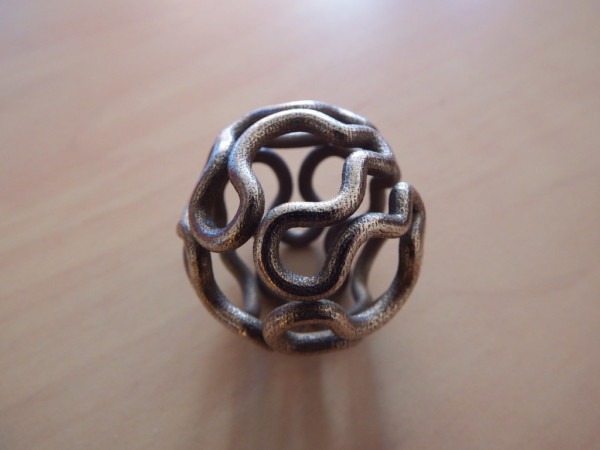 Advantages of DMLS
Advantages of DMLS
- Strong, durable parts
- Parts can be designed to be up to 60% lighter than the same machined part
- Minimal waste (additive technology)
- Fewer geometrical design restrictions compared to traditional methods
- Less energy consumption
Disadvantages of DMLS
- Not available on mass production scale due to slow printing speed (costly and time-consuming)
- Limited build volume
- Expensive (can be around $0.60 per gram)
Applications of DMLS
DMLS has a wide range of uses because it can create customized metal parts with few restrictions to geometrical design. The most common uses for DMLS parts are in the aerospace, automotive, medical, and dental industries. DMLS can also be used to create jewelry from precious metals, but because these materials are so expensive, it is less common to find DMLS being used for this purpose. Speaking in more broad categories, however, DMLS can be used for the following applications:
 Cosmetic Prototypes – Bead-blasting in post-processing results in a smooth, clean aesthetic surface finish that can serve as a late-stage cosmetic prototype to give you an accurate representation of how the part will look once it is machined before you begin production.
Cosmetic Prototypes – Bead-blasting in post-processing results in a smooth, clean aesthetic surface finish that can serve as a late-stage cosmetic prototype to give you an accurate representation of how the part will look once it is machined before you begin production.- Fit Testing – DMLS creates parts with a grainy surface finish, but once this is removed in post-processing, parts may be utilized for precise fit testing.
- Functional Parts – The strength of metal most often exceeds that of plastic, making it capable of supporting heavier loads such as are found in demanding work environments. DMLS parts may also serve as implants, fixtures, tooling, jigs, and more.
- High Temp – Most metals tolerate extreme heat well, which is why they are used in the aerospace and automotive industries and other high heat environments.
The Printing Process
As with all other 3D printing technologies, the DMLS printing process first slices your design into cross-sectional layers that it will use as a guide so your part is created layer by layer. These layers are recreated in physical form by depositing unsintered metal powder across the entire surface of a walled print bed 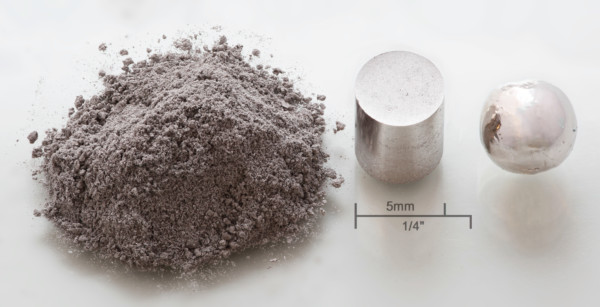 and tracing each layer’s design with a high-powered ytterbium fiber laser so that the powder sinters together. More specifically, this process is accomplished as follows:
and tracing each layer’s design with a high-powered ytterbium fiber laser so that the powder sinters together. More specifically, this process is accomplished as follows:
The print bed is enclosed within a controlled build chamber that is heated to just below the material’s melting point and filled with inert gas, typically argon or nitrogen. Two high frequency scanning mirrors then guide the laser along the path of the layer so that all powder the laser comes into contact with melts and solidifies together. Once one layer is complete, the build platform lowers itself by one layer height, more powder is deposited, and the process is repeated until the part is finished. Any unsintered powder is removed and recycled in post-processing to be used in future printing jobs.
Support Structures
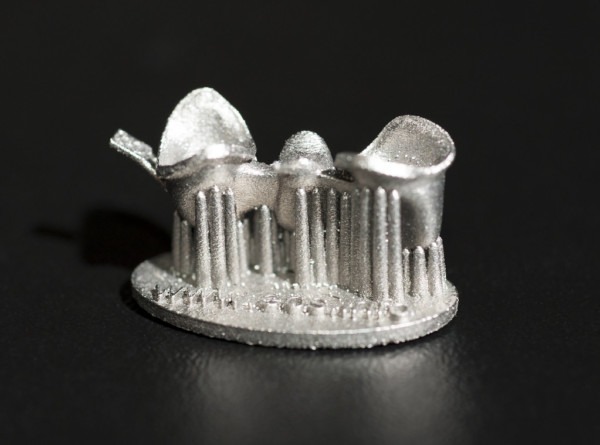 In order for your part to be made correctly, support structures are often used. These are made from the same material as your part and, therefore, will need to be manually clipped off in post-processing. They are typically built in a lattice pattern so that optimum support platforms are created for your print. They also serve the purpose of anchoring the part to the build platform, drawing some heat away from the part to allow for stable, controlled cooling, and preventing warping.
In order for your part to be made correctly, support structures are often used. These are made from the same material as your part and, therefore, will need to be manually clipped off in post-processing. They are typically built in a lattice pattern so that optimum support platforms are created for your print. They also serve the purpose of anchoring the part to the build platform, drawing some heat away from the part to allow for stable, controlled cooling, and preventing warping.
It is important to note that while part orientation is important to achieve maximum part strength, this may increase the number of supports created, which will also increase the waste produced.
Post-Processing
Before your support structures can be removed, there are other post-processing steps that must be completed. This includes removing excess powder from the printed part and completing a heat-treat cycle while the supports are still attached. This both prevents and 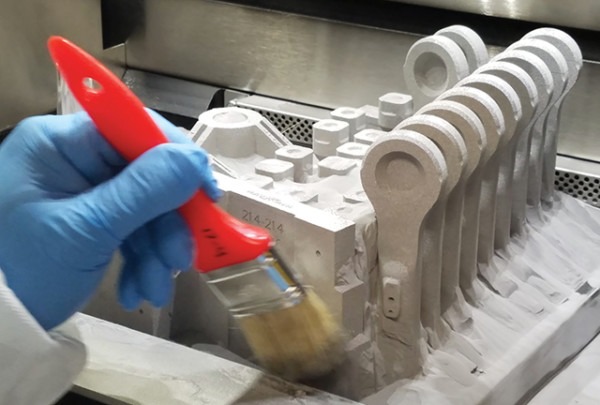 removes stress in the part so that cracks, warp, distortion, and/or delamination will not occur in further post-processing steps. After the heat-treat cycle, the part can be removed from the print bed and trimmed of its support structures. DMLS parts will also need their surface finish cleaned up because the nature of the printing process creates parts with a grainy surface texture. There will also be rough areas left from where the supports were connected. To get a smooth surface finish, the part must be bead blasted and deburred.
removes stress in the part so that cracks, warp, distortion, and/or delamination will not occur in further post-processing steps. After the heat-treat cycle, the part can be removed from the print bed and trimmed of its support structures. DMLS parts will also need their surface finish cleaned up because the nature of the printing process creates parts with a grainy surface texture. There will also be rough areas left from where the supports were connected. To get a smooth surface finish, the part must be bead blasted and deburred.
Differences from SLS
If you are familiar with SLS, you may notice that DMLS’s process is similar in many ways. The most notable differences between the two, however, are DMLS’s use of support structures and homogeneous part creation.
Because metal is more dense than the majority of thermoplastics, DMLS parts cannot be supported by the cake of unsintered powder as plastic parts made with SLS can. This makes support structures necessary for accurate part construction.
In terms of homogeneous versus inhomogeneous part creation, the DMLS process fully melts the metal powder so it is briefly liquified. This allows for a homogeneous bond to be created within the part, which makes the overall part much stronger and more dense. SLS does not perform the same way. Rather, it only fuses the edges of the powder particles together, which makes its part very porous. Additionally, while homogeneous parts are stronger, it is worth noting that flow dynamics should be considered for DMLS as this factor may slightly alter the resulting print resolution you receive.
Materials
DMLS can print in a range of metals, including aluminum, steel, brass, copper, bronze, sterling silver, gold, platinum, and titanium. Many of these are high-performance materials that boast varying degrees of heat resistance, corrosion resistance, strength, weldability, and ductility. Some materials even offer biocompatibility. Below, we’ve covered the most common DMLS materials you’ll find on the market:
Stainless Steel 17-4 PH
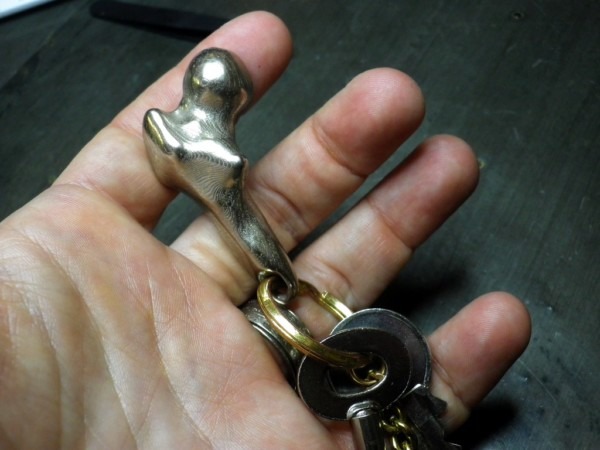 Pre-alloyed precipitation hardenable stainless steel
Pre-alloyed precipitation hardenable stainless steel- Weldable
- Ductile
- High strength
- Corrosion resistant
- Can be heat treated (both heat hardening and annealing)
- Commonly used in the oil and gas industry and for medical equipment
Stainless Steel 316L
- Weldable
- Ductile
- Good strength
- Improved corrosion resistance due to added molybdenum
- Creep resistant
- Cannot be heat hardened
- Commonly used in the medical, aerospace, automotive, and consumer industries
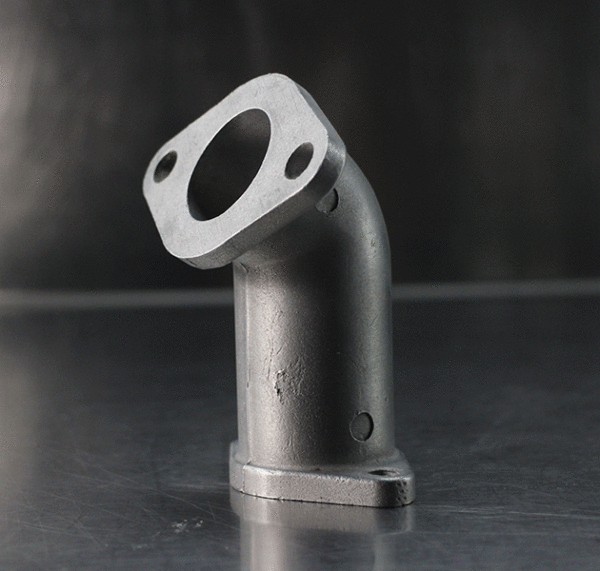 Aluminum AlSi10Mg
Aluminum AlSi10Mg
- High strength
- High hardness
- Low weight
- Thermal resistant
- Commonly used in the aerospace and automotive industries and as lower cost prototypes and parts with complex geometries or thin walls
INCONEL 625
- Nickel-based super alloy
- Non-magnetic
- Corrosion resistant
- High creep resistance
- High tensile strength
- High rupture strength
- Commonly used in the oil, petroleum, and natural gas industry and in turbine engines and fuel systems
INCONEL 718
- Nickel-based super alloy
- Non-magnetic
- Corrosion resistant
- Fatigue resistant
- High creep resistance
- High tensile strength
- High rupture strength
- Commonly used in the oil, petroleum, and natural gas industry and in turbine engines and instrumentation parts and fasteners
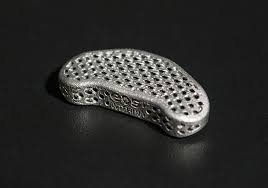 Titanium Ti64
Titanium Ti64
- Biocompatible
- Corrosion resistant
- Low specific weight
- Commonly used in the motor racing and aerospace industries and as biomedical implants
Cobalt Chrome CoCrMo
- Biocompatible
- High tensile strength
- High hardness
- Commonly used in the dental industry as custom crowns, bridges, etc.
MONEL K500
- Nickel-copper alloy (also includes titanium and aluminum)
- High strength
- High corrosion resistance
- Age hardenable
- Can be heat treated via Hot Isostatic Press (HIP)
- Liquid oxygen compatible
- Commonly used in the aerospace industry for liquid rocket engines, LOX manifolds and injectors, and more
 Copper C18150
Copper C18150
- Compound of chromium, zirconium, and copper (CuCr1Zr)
- Stable up to 700°F
- Thermal and electrical conductivity
- Age hardenable
- Commonly used in parts requiring excellent thermal and electrical conductivity
Alternatives to DMLS
In some cases, DMLS will not be the best choice for your part’s production. This can be due to several factors, but the primary reasons are most often cost and production volume.
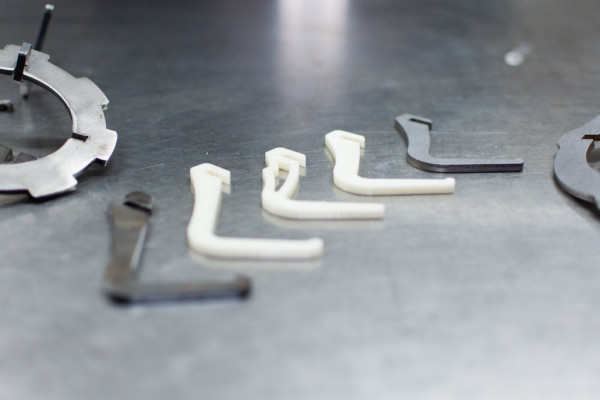 While advancements are being made in metal 3D printing methods and techniques, DMLS is still a slow, expensive process that does not lend itself to high volume output. Traditional CNC machining, however, is capable of a higher volume production where the increased output speed equates to overall cut costs. If you are planning to produce your part in larger quantities, CNC machining may prove to be more beneficial. However, if your part would benefit more from the geometrical freedom of DMLS printing, staying true to design with a higher cost attached may be the better choice.
While advancements are being made in metal 3D printing methods and techniques, DMLS is still a slow, expensive process that does not lend itself to high volume output. Traditional CNC machining, however, is capable of a higher volume production where the increased output speed equates to overall cut costs. If you are planning to produce your part in larger quantities, CNC machining may prove to be more beneficial. However, if your part would benefit more from the geometrical freedom of DMLS printing, staying true to design with a higher cost attached may be the better choice.
Additionally, you may consider your part’s use and find that you can achieve the same results with a high-performance plastic that you would with metal. By going the route of plastic 3D printing or injection molding, you may be able to drastically lower your costs without sacrificing the functionality of your part.
Ultimately, it is most important to keep your part’s intended use in mind when choosing the best technology for production.
3D Printing at 3 Space
Here at 3 Space, we offer multiple manufacturing technologies, including plastic injection molding and plastic 3D printing. If you would like to learn more about our process and available materials or speak to one of our expert engineers, contact us today.
